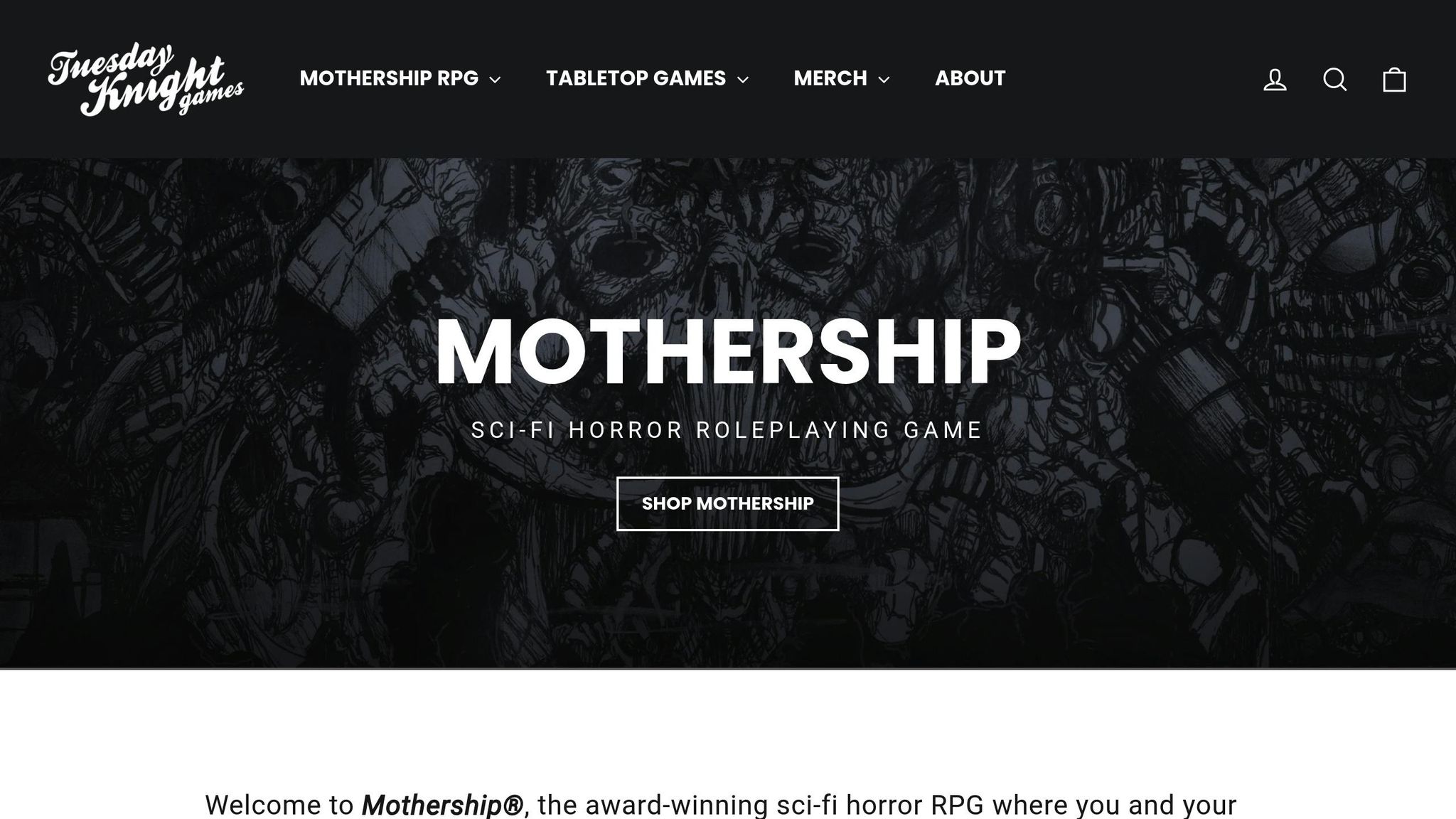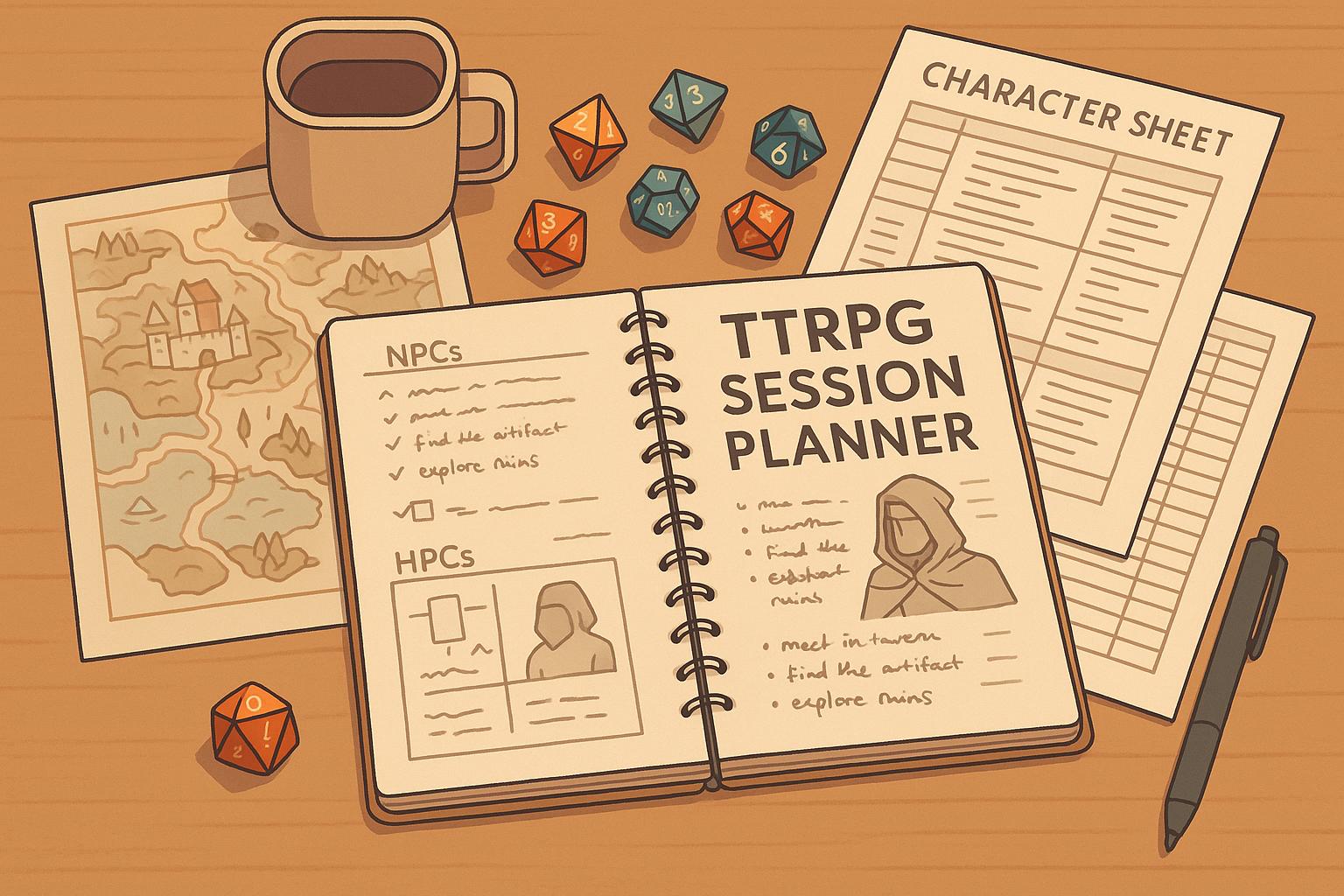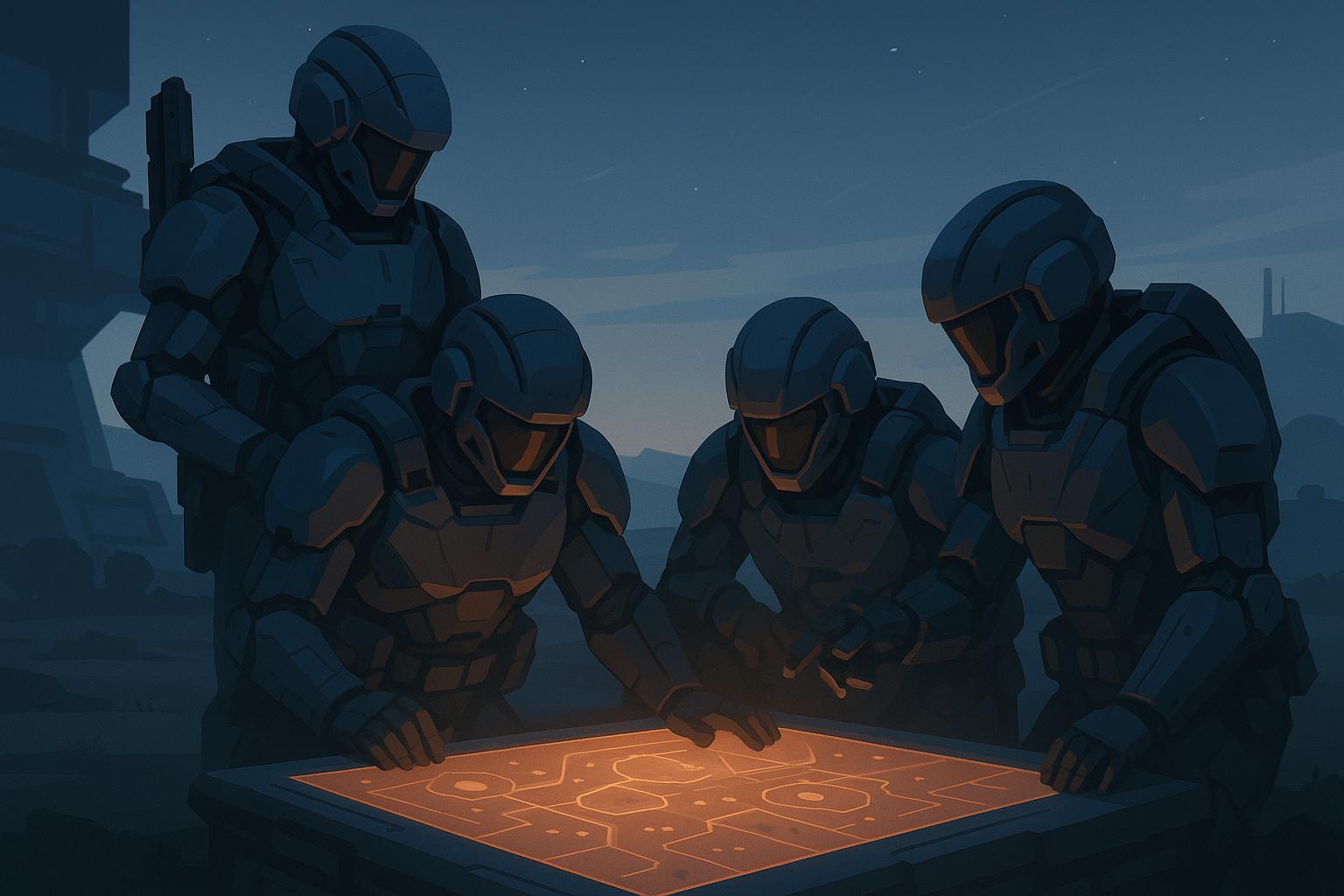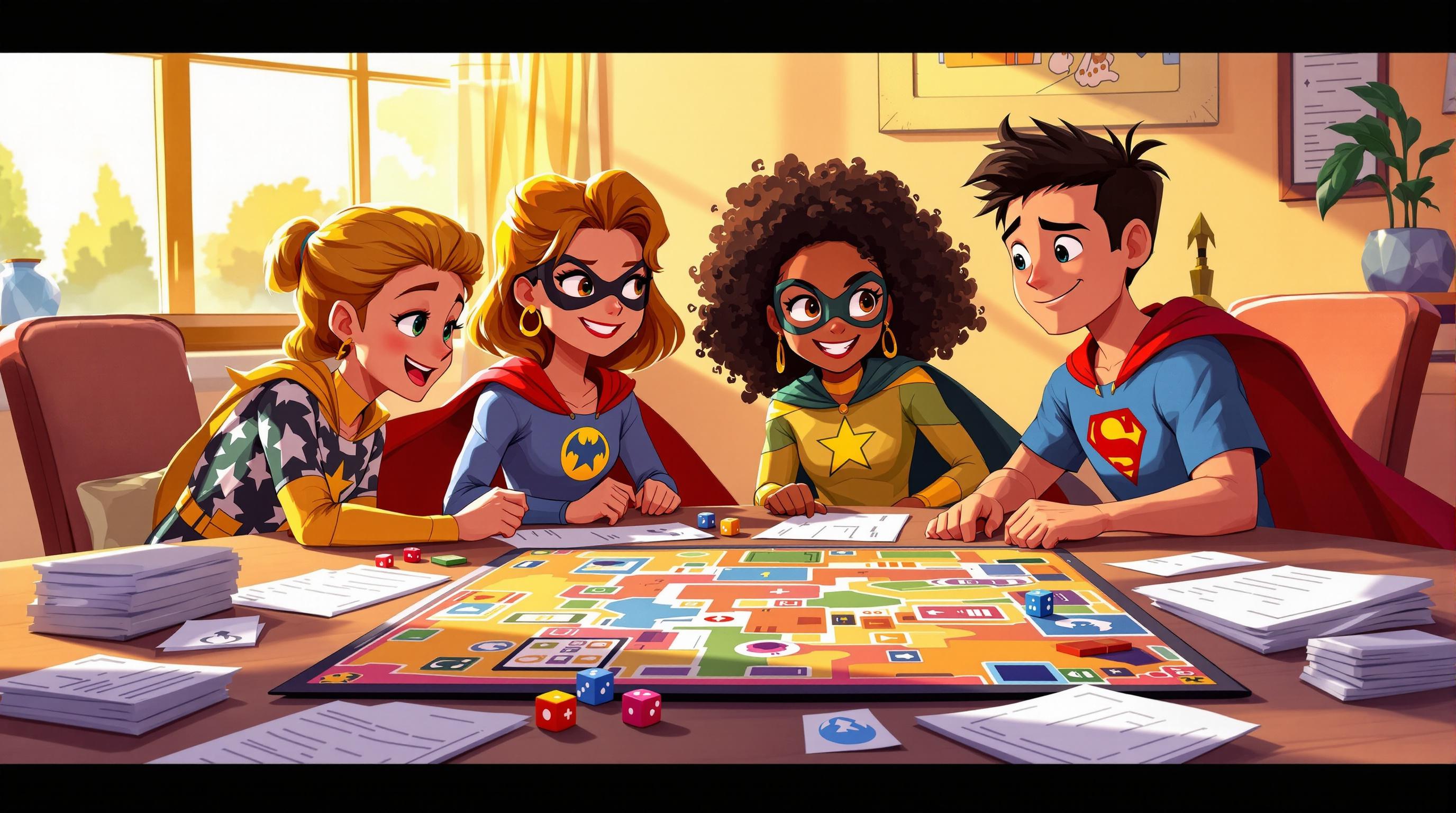NSR, or New School Renaissance, is a modern approach to tabletop RPGs that focuses on simple rules, creative storytelling, and unconventional settings. It builds on old-school RPG principles but emphasizes flexibility and player-driven narratives. Here's what makes NSR unique:
- Minimalist Rules: Core mechanics are streamlined, often fitting on a single page.
- Emergent Storytelling: Stories develop naturally through gameplay, not pre-written plots.
- Unique Settings: Moves beyond standard fantasy tropes, embracing "weird" and mixed genres.
- Player Choice: Encourages problem-solving and creativity over strict rule adherence.
- Collaborative Gameplay: Players and Game Masters work together to shape the story.
Popular NSR games like Troika! and Mothership RPG showcase these principles with imaginative worlds and innovative mechanics. NSR is ideal for players who want a mix of simplicity, creativity, and meaningful choices in their RPG experiences.
NSR Main Design Principles
Simple Rules and Player Choice
NSR games are built around a minimalist approach, with core mechanics often condensed onto a single page. This simplicity shifts the focus from intricate character builds to creative problem-solving. Game Masters can make quick decisions, ensuring the story keeps moving without getting bogged down by overly complex rules. The philosophy of "rulings not rules" encourages players to think outside the box and interact with the game world in inventive ways.
Story-First Game Design
Efficiency in design also extends to storytelling. NSR systems prioritize stories that emerge naturally during gameplay rather than relying on pre-written scripts. This creates a dynamic game world where events unfold organically, and player choices have real weight. The narrative evolves based on what players do, rather than being confined by rigid rules or predetermined outcomes.
Mixed Genres and New Ideas
Breaking away from traditional fantasy settings, NSR games embrace what designers often refer to as "weirdness". This creative freedom allows for unusual genre mashups and inventive mechanics that challenge players while encouraging their sense of agency. Since gaining traction after 2013, the movement has reflected modern game design trends, blending old-school gameplay with fresh ideas. By pushing genre boundaries and emphasizing the creators' vision, NSR systems offer something distinct and engaging.
These guiding principles set NSR systems apart from more traditional approaches and pave the way for exploring standout games within this movement.
NSR vs Classic RPG Systems
Rules and Learning Curve
NSR games focus on simplified mechanics that make them easy to pick up, yet they still provide depth for seasoned players. Unlike classic RPGs that often require wading through thick rulebooks, NSR systems boil the essentials down to just a few pages. This makes them a welcoming choice for beginners while keeping the gameplay engaging for those with more experience.
"NSR: like OSR but with more modern and streamlined mechanics, rather than strictly d20+modifier, yet generally aiming for the same gritty feel. Often just lumped in with core OSR products." - Vecna_Is_My_Co-Pilot
This simplicity doesn’t mean sacrificing complexity. Instead, it opens the door for fresh approaches to character and story development.
Character Growth Systems
In NSR games, character progression feels more natural and tied to the story. Instead of relying on abstract experience points (XP), characters grow through in-game events and achievements. This stands in contrast to the structured, level-based advancement found in classic RPGs.
| Aspect | NSR Games | Classic RPGs |
|---|---|---|
| Growth Mechanism | In-game achievements | Experience points (XP) |
| Skill Acquisition | Learning from NPCs, artifacts | Predetermined abilities |
| Character Development | Organic story evolution | Structured paths |
| Advancement Speed | Narrative-based | XP-based |
A standout feature in some NSR games is the "fail upwards" mechanic, where characters gain new abilities by enduring and surviving tough situations. This approach not only reshapes character growth but also redefines how storytelling is shared between players and Game Masters (GMs).
Shared Storytelling Methods
NSR games take their streamlined mechanics and use them to foster collaborative storytelling. They encourage players to think critically, solve problems together, and explore open-ended scenarios with no single "correct" solution. This design philosophy emphasizes:
- Thinking beyond the constraints of character sheets
- Solving problems as a group rather than relying on strict rules
- Tackling scenarios that allow for multiple creative outcomes
"The NSR (New School Revolution) essentially take the 'old-school' play style from the OSR and create new and incompatible rulesets from them (or, at least incompatible with D&D). These include Cairn, Mothership, Night Tripper, and (kinda) Troika. These trend towards minimalism, but in reality just need to be rules-light." - StaggeredAmusementM
This approach results in a storytelling experience that feels fluid and encourages player creativity while preserving the gritty tone that many players love.
Popular NSR Games
Troika! Game Systems
Troika! is a standout example of the NSR design approach. This game takes players on a journey through a world filled with eldritch portals and labyrinths that defy conventional geometry. Its character creation system, based on the d66 Background Table, breaks away from the usual RPG tropes. Instead of standard archetypes, players might find themselves embodying characters like a Necromancer with a clingy ghost companion, a Nunslinger armed with an energy pistol, or a Temple Knight who’s on the run after stealing sacred swords.
"Troika!: a science-fantasy RPG in which players travel by eldritch portal and non-Euclidean labyrinth and golden-sailed barge between the uncountable crystal spheres strung delicately across the hump-backed sky... The adventure and wonder is in the gaps; your game will be defined by the ways in which you fill them." – Daniel Sell
This emphasis on imagination and open-ended storytelling makes Troika! a hallmark of NSR creativity. Other games, like Mothership RPG, also embody these principles in unique ways.
Mothership RPG Features

Mothership RPG, which won the "2019 Best Game" award for its Player's Survival Guide, is another shining example of NSR design. The game’s mechanics - like its d20 Panic Die and reworked stress system - create a tense and immersive experience. Here’s a closer look at some of its standout features:
| Feature | Implementation | Benefit |
|---|---|---|
| Panic Engine | d100-based system | Clear success rates |
| Character Creation | Rules printed on character sheet | Quick and easy setup |
| Combat System | "Roll to hit, roll damage" | Simplified and fast-paced |
| Health Management | Wounds system | Tracks specific injuries |
| Character Growth | Shore Leave mechanics | Encourages story-driven progression |
Since its launch in 2017, Mothership RPG has received widespread acclaim for its innovative design:
"A master class in presenting RPG rules and settings in a very graphical, readable, and gameable way. And it just looks gorgeous." – Boing Boing
"Such a great example of design in RPGs... If I was gonna run a sci-fi horror game this is the only game I'd use.... Strongly recommended." – Questing Beast
These features and accolades highlight how Mothership RPG has set a new standard for sci-fi horror tabletop games, blending streamlined mechanics with engaging storytelling.
sbb-itb-b8b00a5
Yochai Gal & Cairn
NSR Game Design Resources
NSR game design thrives on simplicity and collaboration, using shared tools and adaptable mechanics to encourage creativity and dynamic storytelling.
Open Source and Community Tools
Collaboration is at the heart of NSR design. Platforms like Fari.community's Keeper bring together open-source tools such as Yochai Gal's Cairn and Jason Tocci's 24XX, making them accessible for designers looking to push creative boundaries. Communities on Discord, Bluesky, and GitHub act as vital spaces where designers share ideas, refine mechanics, and develop new concepts.
Quick Stats and Random Tables
NSR games rely on straightforward statistics and random generators to keep the gameplay fast-paced and flexible. Instead of following a rigid storyline, the narrative unfolds naturally through player decisions.
Here are some of the tools commonly used in NSR games:
| Tool Type | Purpose | Use |
|---|---|---|
| Wandering Monster Tables | Introduces dynamic encounters | Random rolls create unexpected challenges |
| Reaction Rolls | Shapes NPC interactions | Simple d6 or d20 rolls guide character responses |
| Living World Events | Builds background narrative | Tables generate ongoing changes in the world |
| Character Generation | Speeds up game setup | One-roll systems create quick character backstories |
These tools emphasize "external interaction", where players engage with the game world through natural dialogue before mechanics come into play. This method enhances immersion, keeping the game flowing seamlessly.
The concept of a living world is a cornerstone of NSR design. Using random tables and quick-reference tools, game masters can craft ever-changing scenarios where factions rise, fall, and evolve independently of player actions. This dynamic approach ensures the game world feels alive, with events unfolding logically while still responding to player choices. These resources reinforce NSR's focus on emergent storytelling and player-driven gameplay.
Closing Thoughts
The New School Renaissance (NSR) marks a major shift in tabletop RPG design, focusing on simplicity and creative storytelling. By prioritizing straightforward rules and narratives that emerge naturally, NSR draws in players who enjoy a mix of strategic thinking and immersive storytelling.
This design philosophy reshapes gameplay, ensuring every session feels like a brand-new adventure. Its embrace of unusual settings and evolving worlds adds a layer of unpredictability, as game environments grow and change independently of the characters. This creates rich opportunities for discovery and interaction that feel genuinely meaningful.
What truly sets NSR apart is its collaborative approach. Players and Game Masters work together to craft stories without being tied to rigid structures. This flexibility invites experimentation while staying true to the movement’s core values, uniting a wide range of gaming experiences under a shared creative vision.
FAQs
How is the New School Renaissance (NSR) different from traditional RPG systems in terms of gameplay?
The New School Renaissance (NSR) brings a refreshing twist to tabletop RPGs, putting the spotlight on rules-light systems, player-driven storytelling, and imaginative exploration. Instead of sticking to a rigid, pre-planned storyline, NSR games let the narrative unfold naturally through player choices and interactions within the game world.
What sets NSR apart is its focus on accessibility and creativity. These games are designed to be approachable for newcomers while also giving designers room to experiment with inventive mechanics and settings. Many NSR adventures take place in strange, 'Weird' worlds that spark curiosity and invite discovery, creating an experience that feels open-ended and engaging for today’s players and creators.
What are some unique genres or settings explored in NSR games beyond traditional fantasy?
NSR games often challenge the norms of traditional role-playing by diving into bold genres and settings. Take Mothership, for instance - it throws players into the spine-chilling realm of sci-fi horror, where they navigate high-stakes survival scenarios aboard abandoned spaceships. On the other hand, Troika! delivers a colorful mix of science-fantasy, featuring surreal landscapes, eccentric characters, and wildly unpredictable narratives.
What makes these games stand out is their ability to break free from the typical medieval fantasy mold. By introducing inventive and unexpected settings, they open the door for players and creators to explore boundless creative possibilities.
What is the 'fail upwards' mechanic in NSR games, and how does it improve storytelling and character growth?
The 'fail upwards' mechanic in New School Renaissance (NSR) games takes failure and turns it into a springboard for the story. Instead of stopping the action, a failed attempt nudges the narrative in a new direction - introducing fresh challenges or unexpected opportunities. This keeps the game lively and ensures that even mistakes push the plot forward.
On a deeper level, this mechanic plays a key role in character development. It highlights how characters handle pressure, exposing their flaws, resourcefulness, or determination. These moments of struggle add layers to their personalities and histories, making them feel more human and relatable. By treating failure as a valuable part of the adventure, NSR games encourage creativity and unlock richer, more immersive storytelling for players and game masters alike.


